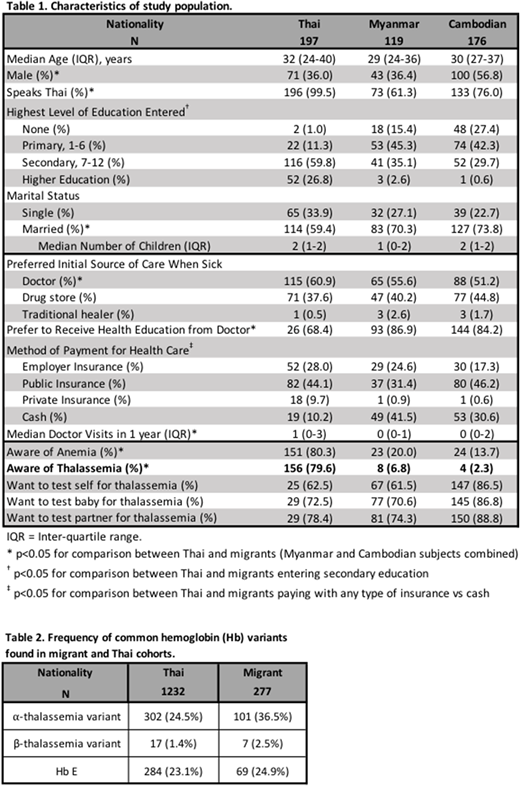Abstract
BACKGROUND: Thalassemia syndromes are inherited hemoglobin (Hb) disorders that most severely affect Southeast Asia (SEA). As a result of population migration, thalassemia has grown into a global health issue, posing challenges to health services in many host countries. However, little attention has been paid to mass migration within SEA and its implications for regional prevention and control of Hb disorders. Thailand, with one of the highest burdens of thalassemia in the world, has a successful national prevention and control program, but ~4 million migrants living in Thailand, largely from neighboring countries, are excluded. Lack of thalassemia screening and diagnosis for migrants may undermine national efforts to prevent new births with severe thalassemia. Strategies for thalassemia screening in migrants are needed. Therefore, we sought to characterize the burden of disease, as well as the knowledge, attitudes, and practices (KAP) of migrants surrounding thalassemia in Thailand.
METHODS: We surveyed Myanmar and Cambodian migrant workers (age 18-49 years) presenting for health registration and Thai subjects presenting for outpatient care at Laem Chabang Hospital (Chonburi, Thailand). Demographic and KAP surveys were developed and assessed for face and ethnographic validity. Demographic surveys were completed by all subjects. Only subjects with awareness of thalassemia completed the 31-question KAP survey. We offered thalassemia testing to all migrants and compared frequency of Hb variants in our migrant cohort to a Thai cohort. Statistical analysis was performed using SAS 9.4 (SAS Systems, Cary, NC). The study was approved by ethical review boards at Mahidol and Duke Universities.
RESULTS: Median age was similar in the three nationalities (Table 1). Migrants were more likely to be married (p=0.003). Only 33.9% of migrants had entered secondary education, compared to 87.6% of Thai. ~30% of migrants did not speak any Thai. Fewer migrants attended doctor visits and used health insurance compared to Thai (both p<0.0001), but migrants showed a stronger preference for health education from doctors (p=0.01). Interestingly, migrants reported residing in Thailand for a median of 5 years, and the majority had never moved within Thailand. Nonetheless, 24.5% of migrants were still unregistered, and unregistered status was associated with a shorter residence in Thailand (p=0.01) and fewer doctor visits (p=0.0003).
Only 4.1% of migrants had awareness of thalassemia, compared to 79.6% of Thai; a large knowledge gap also existed for awareness of anemia (Table 1). Female gender (OR 2.12 [95% CI 1.05-4.29]; p=0.03), secondary education (OR 2.69 [95% CI 1.08-6.71]; p=0.03), and awareness of anemia (OR 11.07 [95% CI 4.82-25.44]; p<0.0001) predicted thalassemia awareness in Thai, whereas only anemia awareness (OR 4.89 [95% CI 4.89-72.84]; p<0.0001) and length of residence in Thailand (p=0.0002) predicted awareness in migrants.
Among subjects aware of thalassemia, the KAP survey identified important misconceptions in both migrant and Thai populations that may lead to stigmatization of thalassemia carriers and decreased screening uptake. For example, 45.4% and 62.7% of migrants believe that thalassemia is an infectious disease and is rare in Asia, respectively. Though migrants had a lower median knowledge score than Thai (p=0.002), their median attitude score was similar (p=0.21). Both groups generally held positive attitudes towards thalassemia testing, but migrants held particularly negative attitudes towards abortion.
Of those migrants offered thalassemia testing who had available blood samples (n=286), 96.9% consented; 3.1% declined. Interestingly, α- and β-globin variants and Hb E were more common in our migrant cohort than in a Thai cohort characterized separately (Table 2).
DISCUSSION: We conclude that the burden of thalassemia in migrant populations is at least as high as in the Thai population and that thalassemia screening is highly acceptable to migrants. However, a tremendous gap in awareness of thalassemia exists between Thai and migrants, suggesting that public education targeted to migrant populations is desperately needed. Other issues identified, including language barriers, lack of insurance, low healthcare utilization, and negative attitudes toward abortion, merit further consideration when designing future health programs for migrants in Thailand and globally.
Telen:Pfizer, Inc.: Consultancy, Research Funding. Viprakasit:F. Hoffmann-La Roche Ltd: Consultancy, Research Funding; Protagonist Therapeutics: Consultancy, Research Funding; Novartis: Consultancy, Research Funding; Agios: Consultancy, Research Funding.
Author notes
Asterisk with author names denotes non-ASH members.


